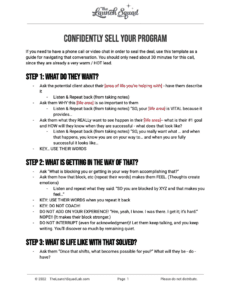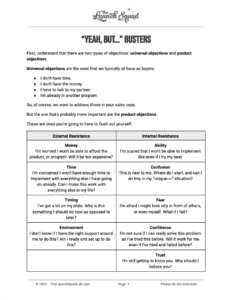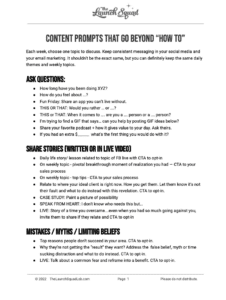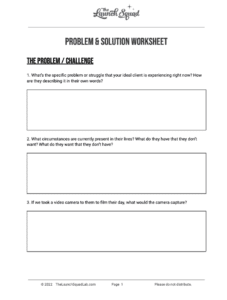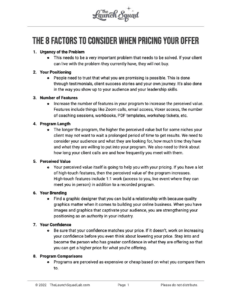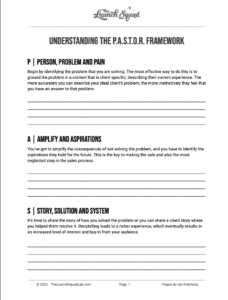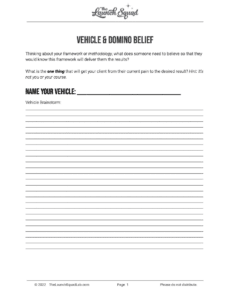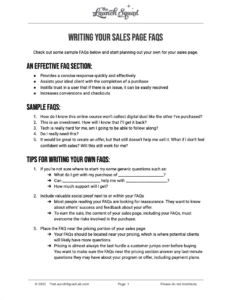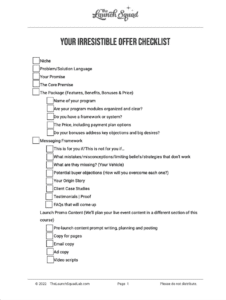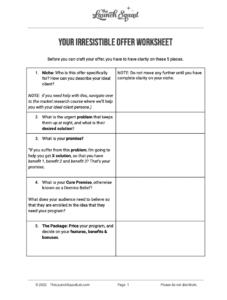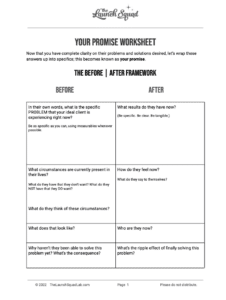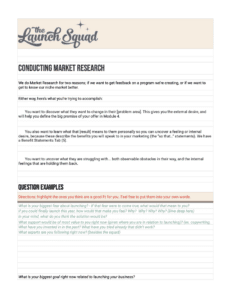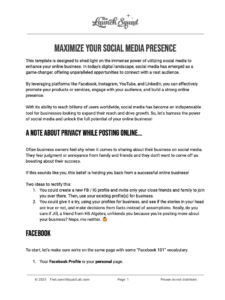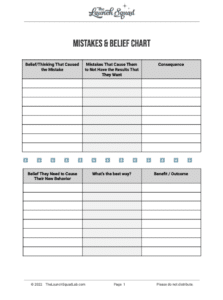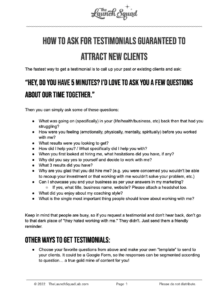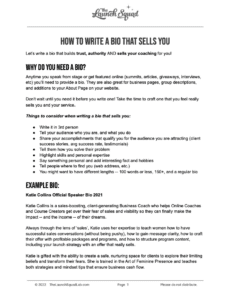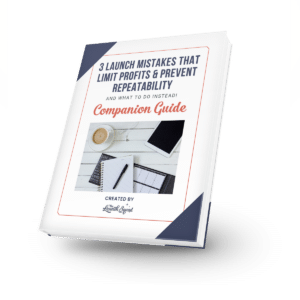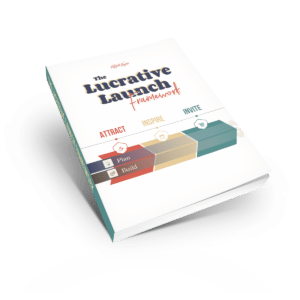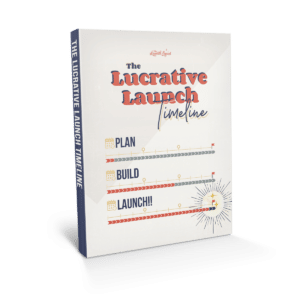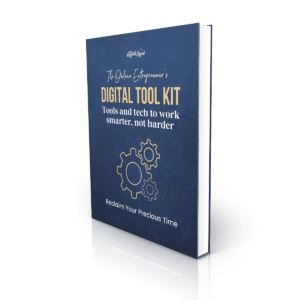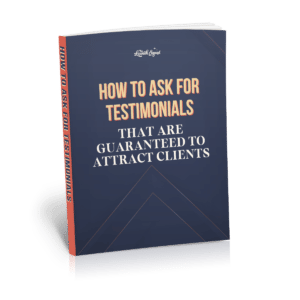In today’s episode we explore the foundation of great content and ways to create months and months of content from just a few minutes of deep work.
Jeffrey: Welcome to the light in your launch podcast today, we're talking about 10 ways. You can create great email and social media content. So stay tuned.
Announcer: Hey, we're in the Launch Squad and this is the Light Your Launch podcast. We teach coaches and course creators how to lighten their launches. We're bringing you all of the tips and strategies to take your launch from intimidating to money-making. In this podcast, we talk about everything; the sales, strategy, mindset, technical and spiritual aspects of running your best launch ever. So if you're feeling overwhelmed and unsure of the next right step, we're here to bring clarity, confidence, and excitement into your next launch. This is the Light Your Launch podcast.
Jeffrey: All right, welcome back to the show. I'm Jeffrey. And I'm back again with Katie. And today we want to talk about 10 ways to create compelling content. Now this is for anyone with writer's block or anyone feeling that resistance to putting out consistent content and showing up, uh, showing up with, uh, tidbits for your audience. So Katie, where do we start with this?
Katie: So I think one of the biggest challenges people have when it comes to putting out that consistent content is that the question is always, but what do I say? What do I write about, you know, what do I, what do I say? So the, the best trick for me was understanding that you you've got to know your pillars of content. And I, I learned to have three pillars. So what do I mean by pillars? So it's like, what's the stuff that you could talk about all day, every day already. Where are you already an expert or what do you believe so firmly in that you say it over and over like a broken record? Um, I would start writing that kind of stuff down.
Jeffrey: If you find yourself, if you find yourself at a party and nobody wants to talk to you because you keep talking about those things, those are your pillars.
Katie: That'll be your fillers. Yay. Now just keep talking about them. No, not at the party though. Um, but I'll give you an example just from like a business coach perspective because, um, a lot of people will say, Oh, well, my pillars are, you know, business coaching. That's what I should talk about. Well, what about business coaching? Because Jeffrey could be considered a business coach and I'm considered a business coach, but we coach on very different things, which is what makes us great partners. Right? So Jeffrey's pillars would be very different than what mine are. And if I tried to write about Jeffrey's pillars, that's when you get stuck with that writer's block because you're not actually an expert in it. And it's like, Oh, what should I say? Right when I did this exercise, I was like, all right. The things I talk about all the time are, um, now I would say leadership skills at the time I use the word consistency.
Katie: I talk a lot about like, you cannot like, let your excuses drive your business behavior. You have to show up consistently, you have to have some sort of schedule or time-blocking system in your calendar. Like if you show up every now and then, or only when you feel like it, it doesn't work that well. So consistency became one of my pillars. Um, another thing I talk about all the time is of course sales that like, I could talk about that till I'm blue in the face. And I ended up breaking that into two different pillars, but at first it was just one, it was heart-centered sales. What does that mean? And then I could, I could break that down, which I'm going to talk about in a minute. And then my third pillar at the time that I was originally doing this was about using speaking to build your business.
Katie: And I had content around that. And then of course, things shifted. COVID came, speaking gigs went away. Well, I'm not going to write about how to use speaking to build your business when we're in a climate where that's impossible to do. Right. Cause that's just frustrating for people. So then I brought back in, okay, I'm going to use, I'm going to break sales into two different pillars, one like mindset around sales and pricing. And then another was the actual sales conversation. How to overcome objections. When should you let someone go? That kind of thing. So what I'm doing naturally, as I'm telling you, this is I'm breaking it into sub categories
Jeffrey: And, and let's, let's, uh, put our numbers on these cause we said 10 ways. So the first one is knowing your pillars. And then the second one is breaking them down to sub categories and micro categories. So dive into that.
Katie: Okay. So we've got sub categories and micro categories. So let me give you a couple examples of what we did for the launch squad. Um, we made a list of, okay, for example, one of our pillars is strategy course. So what sub categories fall under strategy? Well, we need to teach a social strategy. We need to teach a sales strategy. We need to teach a launch strategy and we need to teach a follow-up strategy. Now those are not the only sub categories, but for this episode, I just wanted to focus on these four and they're all day we could be here all day. And I know you guys love our voices, but yeah. Anyway, um, then we'd look at okay for the sub category of social, what are some micro categories that we could talk about when it comes to social media? Um, so one that we came up with was don't rely on social platforms and I already know what that email would be about or what that post would be about.
Katie: And it's get people that you're connecting with off of social media and onto your email list. Why? Because Facebook can be the devil sometimes. And in fact, that is another sub cat micro category that we have is called why we hate Facebook, but they are truly the ruler of the Facebook platform. Of course they own it. So they own your group, they own your page and they can shut you down at any time and you would lose all of your followers. So, so that's an example of a sub category. I just kind of said, okay, here's what the email would look like. Or here's what the social content would look like. Um, all right, I'll give you two other micro categories under social media. I would want to teach how to network online, how to use social media to network, especially during COVID times when things were shut down.
Katie: That was something I talked about quite a bit. Um, and then as I already mentioned, you know, we have this whole one on why we hate Facebook and now I don't know that we'd put that out on the Facebook platform, so to speak. Um, and we might email subject. Yeah. And, and this might even be, you know, Oh, this is just our idea, but we might title that differently. Right. But like, why Facebook makes me want to pull my hair out or something like that. And now we're just talk about some of the things that are happening. Um, especially around election time when they were blocking so much of what we were doing, or I remember offering a purpose and success workshop and they were telling me it was going against community standards. And I was like, Oh yes, purpose and success. Those are very salesy.
Katie: Right? Like I get it. If I get blocked, when I say high ticket, but purpose and success, you know, that's very frustrating. And you see all this fake news on Facebook, but God forbid, anyone hear about my purpose and success workshop. So those are categories of social. So I just want to do one more sub category and I'll just do it around sales strategy. So this is something that I could talk about while I'm sleeping, right. I've been doing this for a long time and I repeat myself over and over for these things that I think are really important. So how to overcome common objections is a very easy sub category. And I could even sorry, micro category, and I could even make that smaller into the different objections. And so I could write an email one day about how to handle, I have to think about it, another email I might write how to handle, um, I can't afford it.
Katie: Right. So we could break those down even more. So here's the thing. Um, Oh, I'll do one more micro category here, you know, um, how to sell with heart. So what's the difference between a pushy sales person that you can't stand? And I just had this experience in my car dealership. I went in to get service and my service advisor was the most sales-y mansplaining guy that did not have my best interests at heart. And I would get that. I understand that if I'm going to a non dealership, just like a regular garage, but when I'm paying for dealership prices in a service advisor, quote, unquote, like you better treat me in a different way. Right. And he was so salesy that I literally left there and said, I will never work with that man again. Okay. So how do you become, so now there's a whole story I could write an email about, but how do you become the heart-centered salesperson that doesn't make someone feel icky at the end of your experience with them?
Katie: So those are just examples of micro categories that fall from the sub categories that fall from the pillar, the pillar being strategy, the sub category being in this case sales and the micro category being heart-centered sales. And what does that actually mean? So, um, Jeffrey's going to go into a little bit more about mind mapping in a minute. Um, but I just want you to understand that the, you know, number one, your pillars can change. Um, they're going to evolve, right. But ask yourself under the overarching theme of who you are. So I'm an energy healer, I'm a career coach. Okay. So that is not a pillar, that's like the overarching theme, but what are three things that you stand for or say over and over that would make the most sense to provide value to your audience? So it has to be a topic that you have several different ideas for if you're feeling stuck. Um, when you do this mind map that Jeffrey's about to talk about, that's a clear indicator that that's not the right pillar. Right. And think bigger. So Jeffrey, tell, tell everybody a little bit more about like what, of course we know what mind mapping is, but how can it be easy because I don't want to draw it on a piece of paper.
Jeffrey: So yeah. Mind mapping is huge and there's, I would recommend, you know, some software. Um, but I'll, I'll, I'll give you a couple ways, a couple of ways, uh, without software, there's the sticky note approach. And I like this because it's tactile. And for all of those tactile people out there, you will probably love this. Um, it's really, you know, go out to staples or whatever, buy herself a couple of packs of stiff, sticky notes, preferably different sizes or different colors, and, you know, perhaps different sizes where you have a big sticky note and you kind of brainstorm some pillars, brainstorm some things that matter to you, some big topics that you like to talk about. And then, you know, just write those down each one separately on a sticky note and then w with the smaller sticky notes or a different color or something, uh, you know, under those what's, you know, micro categories, again, the same concept, sub categories, micro categories, this is what we're doing, but, you know, we can do them with sticky notes or we can actually invest, or, I mean, there, there are free mind mapping software's out there.
Jeffrey: Uh, just do a Google search from mind mapping. You'll, you'll find a bunch, um, depending on what, uh, software, if you're on Mac or PC or whatever. Um, but all they're there for is to get the structure of this sub category of micro category thing in one place. Um, so really, uh, that's, that's kind of what it is. So you're, you're making, uh, the big sticky note is your, is your big categories. And then you might find that some of them can be grouped together and that might identify or help identify a pillar. Right. Um, and then again, booms smaller, um, the smaller sticky notes under those, uh, just more ideas, more micro categories, more micro categories. And if you, if you kind of get stuck here, um, here's a couple of ways you can go about this, call up a friend and start telling them your pair pillars, and start telling them your subcategories and micro categories.
Jeffrey: And when they say what's that, boom, there's some more content when they say, what does that mean? Explain it, you know, you don't have to explain it to them right away, but that's an idea, somebody out there who, who is your audience or something, they might be wondering what some of these, um, topics might be. So as your friends and family, they ask you like, Oh, I don't know what that means. They're more ideas, more micro categories, or you can reach out to other experts in your field and just sort of brainstorm with them. Maybe you have friends who are doing the same thing. They can help you, you can help them. And you can guys can share that and perhaps collaborate together, but that's kind of the, uh, mind mapping. So method number one really is, um, sticky note or mind mapping, and then how you can get more content is with the friends and, and other experts. Um, so that's number three. That's our number three. Is that mind mapping?
Katie: And I, you know, I think, um, here's where the resistance is probably setting in if I know our listeners well, um, you know, I don't, I don't know if time, which is like my, my personal biggest racket. Um, you know, I don't have time thing. Like this is so worth your time. And I remember sitting there with Jeffrey and Aleia and doing it for the launch squad and it really took us no time at all. And there was some, it's something we can always come back to to say, okay, what's our podcast episode going to be about what's our email going to be about, or even what's our next launch theme going to be about, this is always the place that we can come and start at. So it's just so worth the time. And if you're somebody that's been sitting here saying, I don't send emails, or I'm not consistent with my social, um, because I don't know what to say. Then mind mapping is where you start, right? And it's the pillars of course, to the pillars, the sub categories, the micro categories, and then just mind mapping those ideas. And then knowing that it's a living and breathing document that you get to add to at any time, you know, so when something comes up, a questions asked, you're like, Oh, that's a great topic. Add it to your mind map.
Jeffrey: And for anybody who's read, uh, the one thing I'm forgetting the author's name
Katie: That always happens, always happens. Maybe I'll edit it. But,
Jeffrey: Um, the one thing where he talks about the, the domino thing, like the, when you knock over the first domino, what, what's the one thing that by doing, it would make a few other things irrelevant or easy. Like this is one of those big dominoes. When you're thinking about how to construct content for a launch, coming up with it on the fly is not easy and it's not planned, like being able to get all of these ideas out there just makes everything else. Whether it's simple, social posts, random newsletter, emails, or actual launch copy, like so much easier.
Katie: Yeah. Yeah. The authors are Gary Keller and Jay Papasan. There
Jeffrey: We go. Yeah. I knew it
Katie: Pops up. Good. Last name. Um, so Jeffrey, tell me, I always like to ask Jeffrey the kind of tech related questions. Like what websites can people go on if they're like, okay, I've got this sub cat or micro category of how to sell with heart, but what are people's questions related to that? Where can they go? And just look on the internet for people's questions related to that, instead of always asking their audience, what are your questions? What are your questions, which is exhausting for your audience,
Jeffrey: Right. So, boom, number four, where do we get these ideas? And some of the top ones that really work for me is cora.com and read it. And Cora's really helpful because there's just nothing but people asking questions on there. Right? So, um, you know, doing a search for, you know, some of your pillars or some of your subcategories, uh, you just do a search on there, put, put in that keyword and you'll get dozens, hundreds of people asking similar questions or asking questions in a certain way. You know, I mean, wait, we talk about weight loss a lot because it's one of those things that everyone uses that example. But like, if you were to put weight loss in there and you would see that people are asking things like how to lose weight fast, how to quickly lose weight, how to lose weight in seven days, how to lose weight in a week. Like they're asking the same things over and over in different ways. So right there, that's several, uh, micro categories and micro topics, if you will.
Katie: [inaudible] and we did this for our client the other day, and we were just talking about, you know, did people like the word slim or do they like the word slender or is it lose weight? And then we kept seeing, you know, easy and fast were words that kept coming up over and over again, those are the questions they're asking. Right. And so I was like, that has to be your domino belief is that if you work with me, I can help you lose weight quickly or, um, you know, easily without dieting, without, you know, whatever objection that's coming up, but you see what they're concerned about in the questions and then the answers and yeah, it's just a really powerful, um, place to go down the rabbit hole and to see what people have to say. Um,
Jeffrey: I love that we saw a question that was like how to lose weight without exercise or something like that. Yeah. I don't know if that one's going to sit well with people,
Katie: You know, and then I remember I've worked with plenty of people that, um, have that as a niche. And they talked about eliminating the word exercise because people equate exercise as something negative. And so they started using the word movement instead. So really you can inform so many decisions about your copy and the words that you're choosing. And even before you do market research, go down these rabbit holes and just see what's being said, and then, you know, the most important thing when you see what's being said is really taking a stand for or against whatever they're saying.
Jeffrey: And there it is. That really is the key sauce. If you will right. Take a stand on it, believe in it. Um, and that's with everything that's with everything you you're coming up in your content is it's a pillar, right? It's a pillar in your business. So if you don't believe in it, it's going to come through in your copy and it's going to be like, well, what does this person really stand for? If, if you don't stand for something you'll fall for anything.
Katie: Right. I mean, and that's the thing is that people don't trust you if you show up like a people pleaser. Right. So I remember my coach, um, that I was working with at the time when COVID first hit and the question became, should I sell in the middle of a pandemic? And you know, I didn't know the right or the wrong answer at the time. I was just as shaken as everybody else. It wasn't like I was handling that, you know, with ease like, Oh, let me read the book on the former pandemic. Oh, that's right. None of us have ever been through this before. Right. And you know, I remember her saying, Katie, just take a stand either way and stick with it. Yeah. And then I started seeing other people that were doing that. And then I took the stand like, Hey, everybody still needs to make money. Not everybody is negatively impacted as others. There's no need you to sit back and say, I'm going to wait for this to be over. Cause guess what? Look where we are, we're 13 and a half months into this global pandemic. For those, for those who decided to wait, does that mean they haven't made any money in 13 and a half months? Cause I don't know about you, but I'm being a single woman myself. That was not a choice.
Jeffrey: Someone's got to bring home the bacon. Oh, that's you. Okay.
Katie: Yeah. Yep. And so you see how that wouldn't have been on my mind map prior to March of 2020, but it landed on my mind map because it's a living and breathing document. And I went back in and said, Oh wow, here's a whole list of things that I can now talk about. That's COVID-19 related. Yeah. So I'm sorry. Yes. Jeffrey share about this one. Cause this kind of blew, uh, our blew our minds yesterday with our climate. What's the tool that you get that you showed us yesterday on Google.
Jeffrey: So number five is Google related search terms and I'm sure you've, you've, everyone's gone to Google and you start typing something in and you see kind of the suggestions and recommendations. But on top of that, there's a tool for Google Chrome called what's my SERP that's S E R P. And for those who care, it stands for search engine results page. And that's just, you know, the page that search engine returns after user submits a query, they care, they, of course they care, right. Everyone's as geeky as I am.
Katie: Everyone wants to know what's my SERP.
Jeffrey: So, so what that tool does is when you, when you put a search term in there, keyword or something, it will kind of return, uh, some, uh, alternative what others have searched for. So others other related search terms and, and it also quantifies the search volume per month. And this is kind of a cool thing because then you get a quantifiable little, uh, view of which ones are most searched. W w you know, so if something searched four times and then another thing searched, you know, 10,000 times that 10,000 search term is a little bit more popular. So it gives you this idea of like, which one is actually more popular.
Katie: Yeah. Good numbers to have. Right? Like, um, so this kind of brings me into number six, which is using both Amazon books or even going to YouTube. And we got to do this a little bit, um, when we were learning about how to use YouTube ads and, you know, we've got to figure out like, who are we targeting? Cause we're doing those, you know, interrupting your listener content for our five second ad and hoping that you'll continue listening. Um, but it's it's. So again, it's searching your topic as you were your ideal client with their problem, their pain point, their question, and just looking at what's out there, you get title ideas, that way you get subtitle ideas that way. And you can also read the comments that people are writing. And if somebody in the comment section asks a question, boom, answer the question in your email or in your social media, you don't need to say I was on Amazon reading reviews.
Katie: And someone asked a question. You can simply say, I saw a question posted online and I wanted to respond to it here. So it doesn't have to be, you know, directed at you. You can, it's still becomes really great content. So those are amazing search engines. And I think people skip, um, going, you know, they're afraid, Oh, I'm going to go down that rabbit hole. It's going to take me a lot of time. But again, this is what can really inform your mind map. And a lot of times I'm not ahead of the game with my content and I like to be inspired. Um, and I will like pick a card like an Oracle card and write a post about it, or write an email about it or do a Facebook live about it. Um, so these Amazon, you know, going to the Amazon YouTube, same thing, like if you're like, Oh crap, I got to write an email today.
Katie: And anytime you're saying that, right then it's like this like performance anxiety. And then you have the blank page. I don't know what to write. So just hit up one of these options. Um, Amazon books, YouTube, or your own bookcase. Sometimes I'll pull a book off the bookcase. I open to a random page. I let my eyes land on a sentence that I'm meant to read. Um, nine times out of 10, that works for me, but sometimes I'll have to do it two or three pages and be like, Nope, that's not it. Nope. That's not, it it's like dice, but truly pulling a quote out of a book and responding to that quote in some way or how that was meaningful to you are all really easy ways to be able to write that email today right now and get it done.
Jeffrey: So, yeah, and that YouTube, that YouTube trick is really cool because that will also give you kind of a quantifiable popularity of a certain headline. So if you went to YouTube and searched, whatever weight loss, let's just stick with weight loss, you know, you'll get, you know, what are the top 10, uh, videos or, or of the videos that top, that populate that search query. You can see like their title and how many views they have. So you look at the ones who have the most views check out what their title is, and it's obviously popular, right? So it's quantifiable popularity.
Katie: Yeah. Thank you for reading my mind because that's what, like made me go down the YouTube rabbit hole in this conversation, but I forgot to loop it back around. Oh, you can't read my mind listening. Don't worry. Jeffrey can. Yeah. Um, okay. So that was number six, Amazon books, YouTube, or just your own books on the shelf or Oracle cards. Right? So just like resources, number seven is, um, social media image templates. So I sh I'm sure you've seen these in your Facebook ads. Those slow offers, right? The $37, the $27 get my template kit. Those, I allow those to inspire me. So I downloaded one from, I think called viral stars.com. I'm not sure of the woman's name. Um, but it was, um, like a six pack of templates. And so each template thing came with like 20. So it was like 20 times six, right.
Katie: All those, um, prompts. And so they're each labeled, like one is about community and one's about conversion and one is about connection. So I would just open one of those and look at her prompt, like seven ways to X and it's already designed for me and I just sit there and Canva, I duplicate it. And then I'm like seven ways to, Hm. And I like, look around my room and I'm like, Oh yeah, I'm going to write about this seven ways to embrace joy when nothing's going your way. And then I brainstorm seven. Now, if I can't come up with seven, I only came up with five. Guess what I do? I go back up. I changed the title of five ways to praise, joy and call it good. Right. But every time I've done that my audience responds so well to what I put out there.
Katie: And partly because I don't do that all the time. Um, but it is like, it's that inspirational energy, but I am not a blank page girl. I like templates. They just helped me move my thoughts along. I like prompts and things like that. So don't be afraid to download those kinds of things and, and you can make up a story and say, Oh, my content is going to look like everybody else's, but it's not. Maybe the image is going to look similar to what else do you see if you use Canva? That's the case. Right. But there's lots you can do with images in your own branding to make it look like yours. And it's just a great place to start again and get away from the blank page syndrome.
Jeffrey: And I, I think, I think you're, you're talking to 99.9, nine, nine, 9% of people who are listening right now is that we're not blank page people like so many people are like, gosh, you know, they can stare at a blank page for two weeks before. They're like, uh, I should have put this email out seven days ago, you know, but if somebody hands on, like here's an outline, here's a few ideas you can roll with it. You can totally roll with great ideas and improve them, make them better expand on them. And, and that kind of goes back to that mind mapping. And that's why that work is so important is because it just makes sure that you're not starting from a blank slate.
Katie: Right. You know, it's funny. I, um, I was thinking of the metaphor, like around cooking. Like most people can't open the cupboard, open the fridge and be like, this is what we're going to eat. If you can do that. I think you are a freaking rockstar because you know, and like I'm a one on the Enneagram. I'm like, show me the step-by-step my friend, Vanessa always laughs at me because she'll her recipes are like a pinch of this, put that in there. And I'm always texting her. Like, what does a pinch mean? Exactly? Are we talking a teaspoon? Are we talking a tablespoon? She always writes back laughing at me. Like, I, I am not that creative, but I love creating food, but I need a recipe. And so it's the same thing. So don't feel like you're, you know, you're failing in some way.
Katie: If you're not the, let me open up the cabinet and figure out what to make. If you're a recipe person, then you're probably also a template person. So go by the templates and let them help you. Um, because at the end of the day, we're talking social media posts and emails that are going to make an imprint on someone for about 72 hours, it's going to have an impact. And then it disappears. It's like if they didn't open your email within 72 hours of you sending it, they're likely not going to open that email and on social media, as you all know, right. If you put something in a story, it disappears in 24 hours. Um, but with the algorithm I learned from Bridget Brady, she's a great gal to follow for social media stuff. Um, and she was saying, you know, in the algorithm, the content you put out that day, isn't going to be shown days after, unless it's getting huge engagement.
Katie: Yeah. And then it pops back up in people's newsfeeds. So we just have to remember, is it worth spending 90 minutes crafting something that's going to have an impact for 72 hours? Yes. The answer is no, the answer is no. Yeah. Um, all right. So I already mentioned this kind of, but number eight for coming up with content is talking about the creative, the current events that you can relate back to, you know, your business or your niche. So I mentioned that in terms of COVID-19 right, that became a new category that I could put in my pillars. Um, but anything that's happening right now, I mean, gosh, there's so much happening right now in the world. Um, but if you just see any sort of article or headline that really struck your fancy one way or the other, right. If it struck a chord or struck your fancy, um, whenever you post about current events, people know that your content wasn't created nine months ago and reuse, which by the way, there's no problem with that.
Katie: And we're going to talk about that. Um, but you want to keep your content also inspiring and hot and current. So really tracking current events and asking yourself, how does, how can this relate to my business or my niche? And if so, how, um, and then, you know, and even if it's related to the values that you show up in your business, or that you've changed a business practice because you've learned, you know, for example, um, in like the anti-racism training that I had taken last June, um, there were things that I immediately changed in my own practice because I didn't realize that there was a thread of that. Um, because I learned from white coaches who had policies that did not serve all. And I just, I just didn't know. And as I learned new things, I, I shifted, right. And then I did talk about it.
Katie: I posted, you know, an article or, um, Hey, this really got my goat. Like I'm, I'm taking a stand against the coaching industry with these praying practices. Like I was watching a coach at the time, sending her attorneys after people that were not paying their bills in the first month or two of COVID. And it was like, these people lost their jobs, their spouses lost their jobs. They like, you know, the rug got ripped from under them. And I for one was not going to be a coach that demanded payment from people that were in the middle of a global pandemic. I was just going to push the pause button on my policies because they didn't make sense for the times that we were in. So just things like that, um, you know, that you think what the heck does an illness have to do with my business? Oh, actually everything is everything to do with my business. And it was, it became, should you sell during a pandemic? Should you hold up your policies during a pandemic? What are you seeing other people do? That's making you mad right now? What do you disagree with? And you know, all of that. So current events is a great way, um, to just give yourself ideas for more content. All right, Jeffrey, take it home with numbers,
Jeffrey: Number nine, client success stories or case studies stories. And these, these, we love, we love these because these are so powerful on so many levels. First of all, when our clients find success like that is just heartwarming. So for, for starters, it just makes us feel good. Right? And so writing about that and talking to others about that, this feels good. Right. But what we're also doing with that is we're conveying, um, several things. So think about this, you share one of your client's success stories. You're not only establishing yourself as an authority, you're proving that you can deliver results and you're helping your, your potential clients have a relatable story in a situation that they feel that they are in right now, for example, you can say, Oh, my client so-and-so was struggling with this. And they, I helped them do this and they overcame this and this was the results. Right? So as you share that story, there are ton of other people that you're talking to, that you're conveying that story to, that can relate to the situation your client was in, in the beginning of the story. I hope I said that correctly.
Katie: Yeah. I, I, I followed yet. Um, and it's really, it's the inspiration, right? You want your potential clients to raise their hand, say, I want that, you know, one of my favorite ones was, um, I took a quote from an interview I did with a successful client. I put it on a Canva image, you know, that said something like when I first met Katie, I thought she was crazy. And six months later and just was in March of 2020. So this is when the world was collapsing around us in terms of like fear around money. And, and she said, I can pay all my bills for the rest of 20, 20 based on the success I was able to get. Right. Like that, I mean, that captured everyone's attention. And then it was like a link to her story or, um, or even just that image in and of itself.
Katie: Um, other things that work are like screenshots, when your client, you know, inevitably is going to text you and say, Hey, I got this win and you're going to write back woo-hoo or if you're me and Jeffrey, you're going to send a Bitmoji that says high five. Um, and so screenshot that conversation and you don't need to have any identifying information, just show the conversation. If somebody texting you saying that and, and you get to share the story. So it doesn't always have to look like a testimonial, right? It's like this success story. And then it's like, when this person first worked with me, she thought I was crazy and look at what just happened. Right. It doesn't even have to be a long post. It can simply be those simple words and an image. And it makes an impact on your potential buyers brain that if they could do it, if your other client could do it, so can they write, it becomes this inspirational thing for them. And again, that whole thing took me 15 minutes to create, put out there, write the post and get it out there. So those are the right social media posts, 15 minutes or less, um, you know, not all the time, you may spend longer on some, but really this is quick content,
Jeffrey: Quick content. And here's the thing with those case studies, you know, and this leads up to kind of number 10 here is starting with video and repurposing content. But with those, um, client success stories, you can also repurpose that because when, when you have a full story, you've also got little posts, little short snippets that you can put in social media. You also have a full story you might want to put in a blog post or on the website or something like that, or maybe a, a truncated version of that story. That's great for email or something like that. Uh, so number 10 is really, uh, using ideally video to repurpose content. And I'll tell you why. Uh, it could also be audio, but here here's why video is a little bit more powerful because video is at, if you will, the top of the cascading repurposing model.
Jeffrey: So if you think about it in video, you have moving images and audio. So video and audio and something like a podcast, you only have audio. So that's why video is kind of at the top of the level. So if you do video, then you have video content, you have audio content that audio can also be a transcript content. That transcript can also be a blog post. That blog post can also be an email and parts of that email can also be social posts. So you can always kind of cascade down further and further. And maybe from that email or the podcast, sorry, transcript or blog posts, you pull out quotes for additional social posting also with, uh, let's say you had a video and also with that video, you have audio. So now you have a podcast episode, perhaps. And then with that podcast episode, you also have the, um, you know, those little, uh, what do they call them the little 32nd snippets and things like that. So you've got all, suddenly you have all of these other pieces of content that came from one video and again, a video or a podcast. Uh, those are kind of at the top of the food chain, if you will, of repurposing content
Katie: And the algorithms like videos, right. The social media algorithms. And so, um, it, it is, you know, I was just sharing with Jeffrey right before this. Um, and I know we gotta wrap this up, but right before this, I was saying, you know, when I do a live, I make myself listen back every single time. Number one, I want to make sure that the audio quality was there. Um, sometimes I feel like, I don't know if you guys feel this way, but I feel like I'm a little out of my body. Like, I'm like, what did I just say for 40 minutes? I'm hardly ever live for 40 minutes. But, um, but I, I just like to listen back in, in like, was it coherent? Did I make some good points? And often I will hear the sound bite that I want to pull out, but I don't hear it when I say it.
Katie: But sometimes I do sometimes I feel like, Ooh, that was so good, but I can't remember what I said. So I go back and listen. I'm like, okay. Yeah, this is the sound bite. So it, but it's uncomfortable to listen to yourself. And so a lot of people don't do it, but I'll tell you what, it just advances you so much faster in your confidence to do videos because nine times out of 10 you'll watch it and go, wow, that was, that was half good, right? Or, that was really good. And so it just inspires you to do more videos. Um, but you know, you can use services like temi.com to EMI. You can upload the direct link from your live right into Tami. You pay like four or $5. You get the entire transcript and you can hire someone to write a blog post, to pull out your sound bites, to pull out a quote that they're going to make a social media image for. Right. But I've learned you have to do it yourself first and see how much time does this take. What's the process as Jeffrey is going to love, hearing me say, right
Jeffrey: In SOP,
Katie: And that way you're hiring the right person with the right skillset to do the thing that you don't have time to do. But what you need to do first is the video, right? And, and the mind mapping and the figuring out what is your content. Because when I think when you hire out a hundred percent for content writing, um, it just doesn't sound like you. And I hear a lot of my clients say I brought someone on and she was writing blog posts, and they just weren't that good? That didn't sound like me. And it's like, well, because you weren't giving them anything from you, right. You were asking them to repurpose stagnant content, that's on your website. And they can only repurpose that so many times. So you have to keep the dynamic content going, and then they can repurpose it in all sorts of ways.
Jeffrey: And, and when we go, when we're talking about a voice, like if you don't yet have a voice, as Katie was saying, it's much harder to hire out. So, so this goes back to fi so how do you find your voice? Well, part of that is finding your pillars, right? When you have your pillars, and these are the things you talk about, incessantly at parties, and that make you so popular at parties. Nope. That's really, I had a rough childhood. Um, those, those kinds of things, those are the things that carry your voice, right? Because you're passionate about them. You can talk over and over about them, incessantly ad nauseum. No. Uh, but that, that is where those voice, uh, aspects come from. So if you're wondering like, Oh, what is my voice? What is my voice start writing and creating content based on your pillars.
Jeffrey: And you'll, you'll start saying, Oh yeah, this is how I sound. When I'm talking about this, where I'm confident versus something else where I'm not in, that sort of starts developing your voice. And then once you have that, you know, th then you can hand off something, you can hand off that, that job to somebody, because they have, uh, whether it's, you know, videos or anything to go to read back on, to look back on or review and get a sense of who you are and what you sound like. That's then you can hand it off. Yup. Yep. Awesome. All right, everybody, that is the 10. And we're going to run through this again, uh, knowing what your pillar is, number one, and, uh, knowing how to break it down into some categories in micro categories. Number three, mind mapping, number four, searching on Cora and Reddit and other places like that.
Jeffrey: Number five, Google related search terms and using tools like what's my assert, uh, number six, Amazon books and YouTube searches, number seven, social media image templates. Again, you can get those on creative market viral stars, and you'll see them in your Facebook feed. I'm sure every day, number eight, current events and number nine clients, success stories, and number 10 repurposing content starting with videos or audio. All right. Thank you so much for joining us. And if you enjoyed this episode, hit that like, or subscribe and give us a five-star review, uh, and check out all the show notes at the launch squad, lab.com forward slash episode 20. All right, we'll see you next time.
Announcer: Hey, thanks for listening. If you'd like to have clarity, confidence and excitement around your next launch, join us in the Lighten Your Launch Facebook group today at thelaunchsquadlab.com/facebook. We also invite you to download our free gift, the Lighten Your Launch starter kit, the free guide to creating an irresistible offer, pricing it right, overcoming tech barriers, and tapping into the energy you need for success. Get it now at thelaunchsquadlab.com/freegift.
Be the first to know
Enter your name and email and we'll let you know when new episodes release.
About the Show
The Lighten Your Launch Podcast is for Coaches and Course Creators who want a lighter online launch experience. Maybe you’ve done a few launches already, and feel exhausted just thinking about it! Or, it’s been one of your goals, but you don’t know where to start.
Tune in to learn from our team of experts, The Launch Squad, who aren’t afraid to dig into all aspects of launching: sales, strategy, technology, mindset, funnels, and even a bit of woo to get you through the toughest times. Let’s put a stop to perfectionism and procrastination, and finally take your launch from intimidating to money-making!

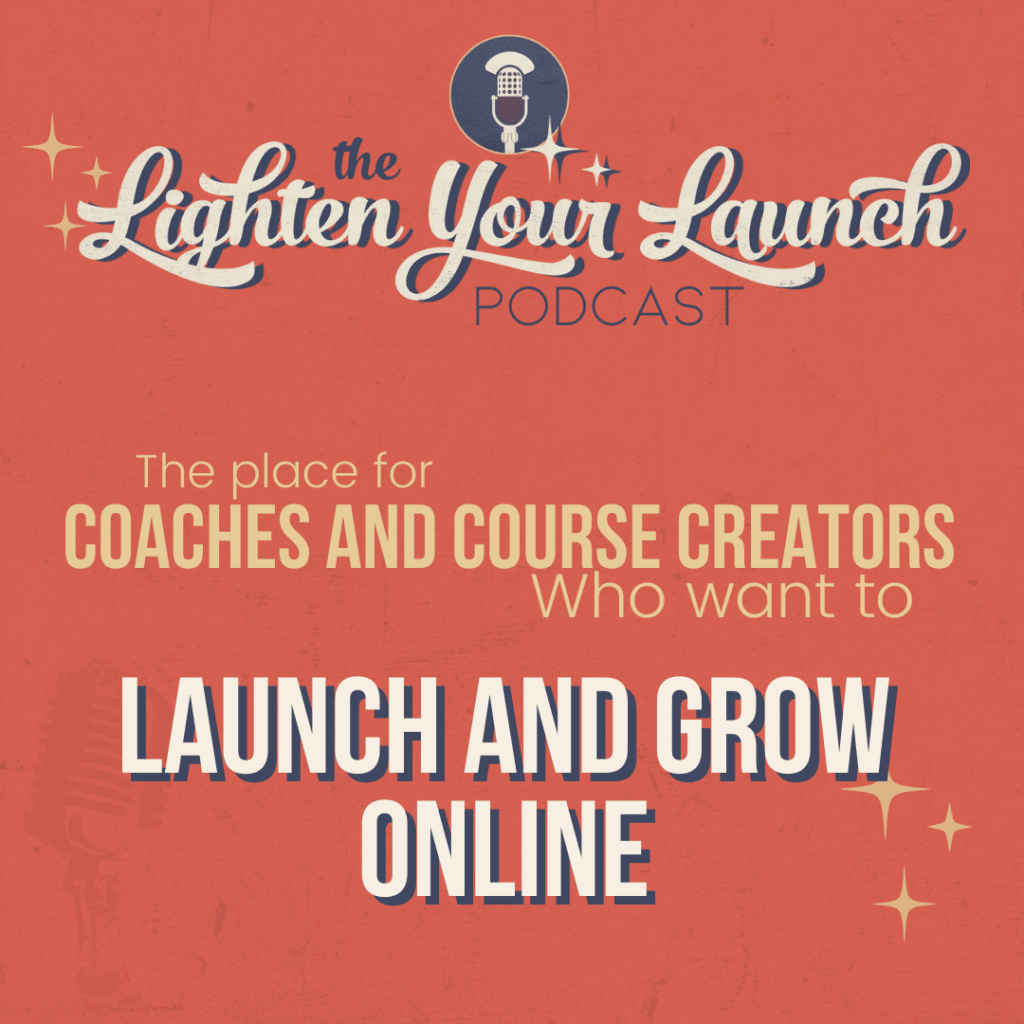
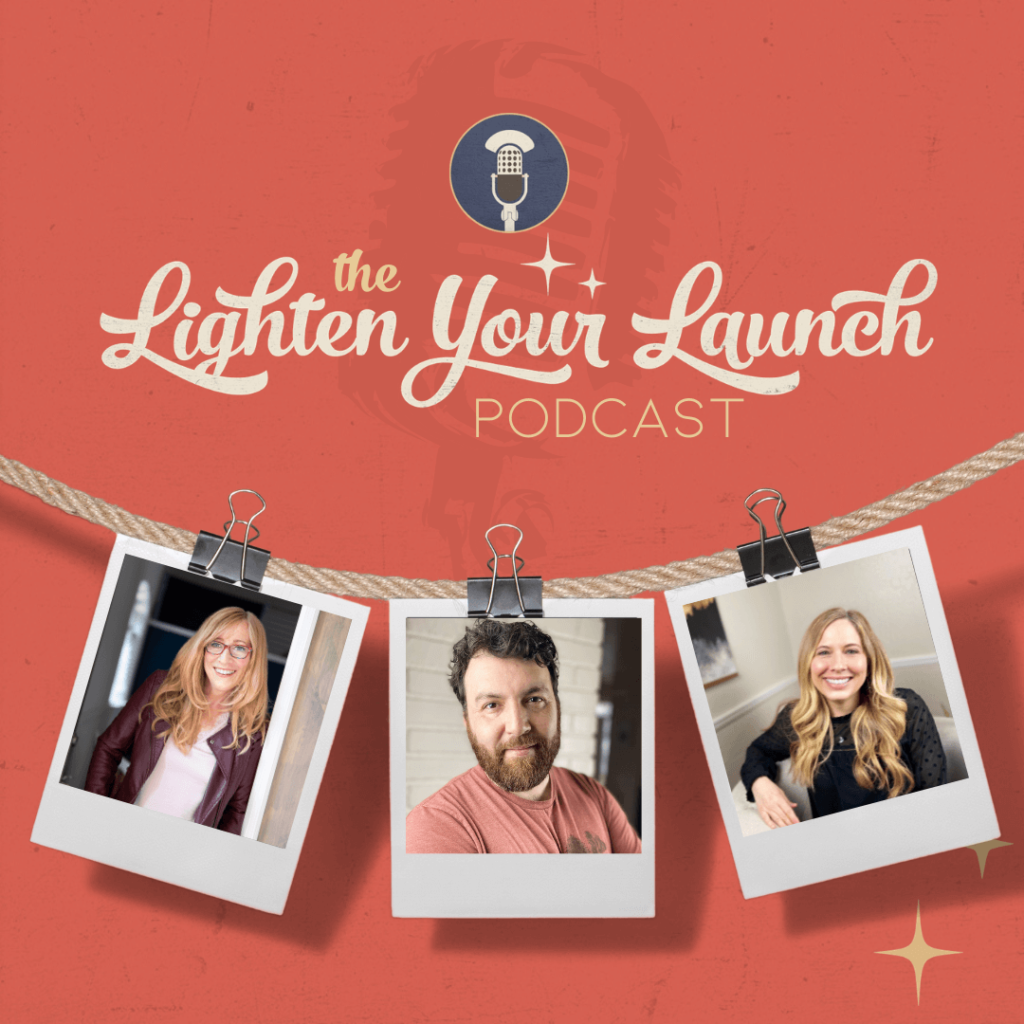


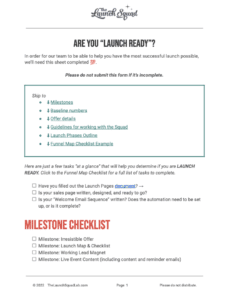
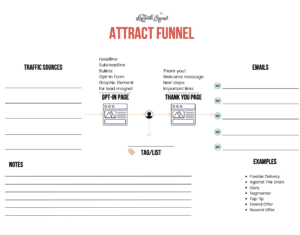
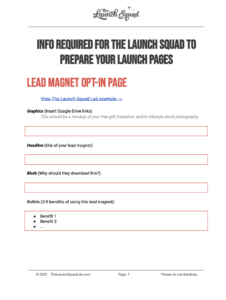
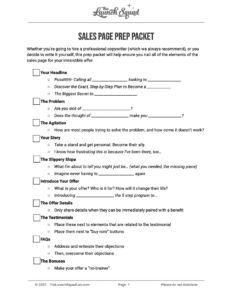
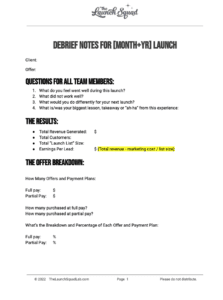
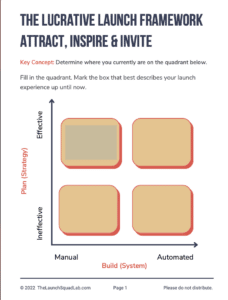
![Marketing Launch Calendar [TEMPLATE]](https://thelaunchsquadlab.com/wp-content/uploads/2023/05/Marketing-Launch-Calendar-TEMPLATE-300x260.png)
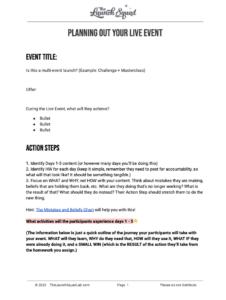
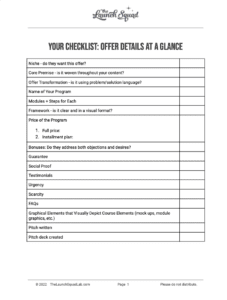
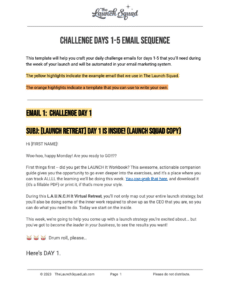
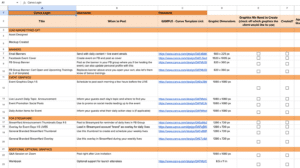
![[Updated] Email Templates for Launch](https://thelaunchsquadlab.com/wp-content/uploads/2023/05/Updated-Email-Templates-for-Launch-223x300.png)
![[REVISED] LS Pitch Script](https://thelaunchsquadlab.com/wp-content/uploads/2023/05/REVISED-LS-Pitch-Script-2023-226x300.png)

